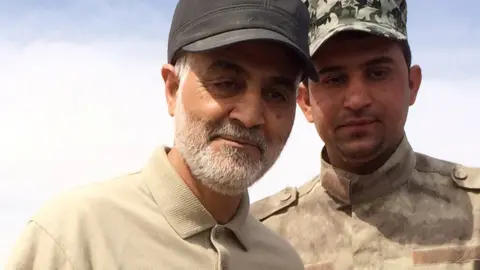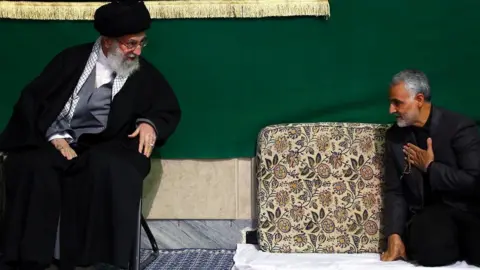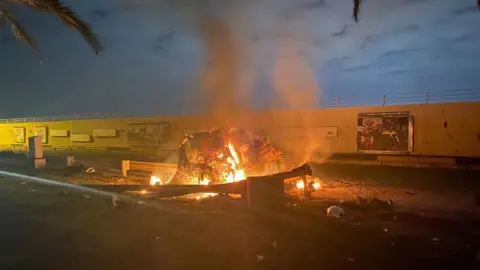Iran's Qasem Soleimani: Why the US had him in its sights
 Reuters
ReutersNext to Iran's Supreme Leader, Qasem Soleimani was arguably the most powerful figure in the Islamic republic.
As head of its military abroad known as the Quds Force, Soleimani was the mastermind behind the country's activities across in the Middle East, and its real foreign minister when it came to matters of war and peace.
He was widely considered an architect of Syrian President Bashar al-Assad's war against rebels in Syria, the rise of pro-Iranian paramilitaries in Iraq, the fight against the Islamic State group, and many battles beyond.
Charismatic and often elusive, the silver-haired commander was revered by some, loathed by others, and a source of myths and social media memes.
He had emerged in recent years from a lifetime in the shadows directing covert operations to achieve fame and popularity in Iran, becoming the subject of documentaries, news reports and even pop songs.
As far back as 2013, former CIA officer John Maguire told The New Yorker that Soleimani was "the single most powerful operative in the Middle East".
When his end came, it was violent and sudden. On 3 January the Pentagon announced that it had carried out a successful operation to kill him, at the direction of US President Donald Trump.
 EPA
EPAThe assassination followed a sharp escalation between the US, Iran and Iran-backed groups in Iraq following the death of a US military contractor in a missile attack on a US base in Iraq - for which the US held Iran responsible.
The US responded with an air strike on the Iran-backed militia Kataib Hezbollah. Militia supporters then attacked the US embassy in Baghdad.
Tensions between the US and Iran had been rising since the US pulled out of a nuclear deal between Iran and world powers to curb Iran's nuclear programme and prevent it from developing nuclear weapons. The US has also reimposed sanctions on Iran, sending its economy into freefall.
Rise of militias
Soleimani is believed to have come from a poor background and to have had very little formal education. But he had risen through the Revolutionary Guards - Iran's elite and most powerful force - and was reportedly close to Iran's Supreme Leader Ayatollah Ali Khomeini.
After becoming commander of the Quds Force in 1998, Soleimani attempted to extend Iran's influence in the Middle East by carrying out covert operations, providing arms to allies and developing networks of militias loyal to Iran.
Over the course of his career he is believed to have aided Shia Muslim and Kurdish groups in Iraq fighting against former dictator Saddam Hussein as well as other groups in the region including the Shia militant group Hezbollah in Lebanon and Islamist organisation Hamas in the Palestinian territories.
After the US invaded Iraq in 2003 he began directing militant groups to carry out attacks against US troops and bases, killing hundreds.
He is also widely credited with finding a strategy for Bashar al-Assad to respond to the armed uprising against him that began in 2011. Iranian assistance along with Russian air support helped turn the tide against rebel forces and in the Syrian government's favour, allowing it to recapture key cities and towns.
Soleimani himself was sometimes pictured at funerals of Iranians killed in Syria and Iraq, where Iran had deployed thousands of combatants and military advisers.
He also travelled frequently across the region, regularly shuttling between Lebanon, Syria and Iraq, where Iranian influence has steadily grown. When he was killed he was travelling in a two-car convoy away from Baghdad airport with others including Kataib Hezbollah leader Abu Mahdi al-Muhandis, who was also killed.
 EPA
EPAIn April 2019, US Secretary of State Mike Pompeo designated Iran's Revolutionary Guards and Quds Force as foreign terrorist organisations.
The Trump administration has said the Quds Force provided funding, training, weapons and equipment to US-designated terrorist groups in the Middle East - including Hezbollah movement and the Palestinian Islamic Jihad group based in Gaza.
In a statement, the Pentagon said Soleimani had been "actively developing plans to attack American diplomats and service members in Iraq and throughout the region".
"General Soleimani and his Quds Force were responsible for the deaths of hundreds of American and coalition service members and the wounding of thousands more," it added.
